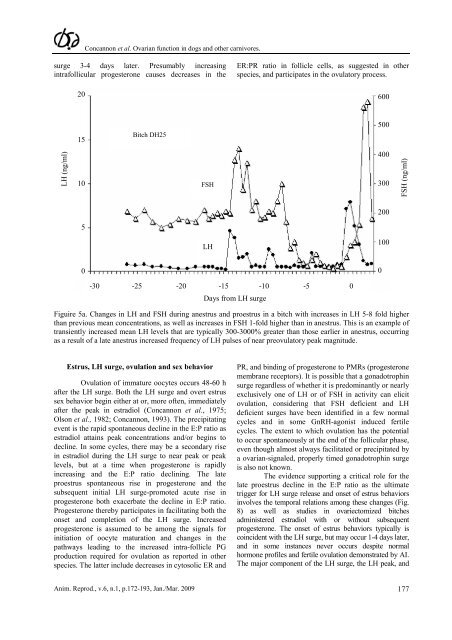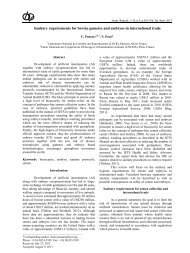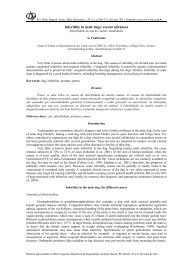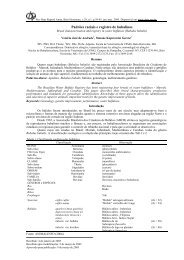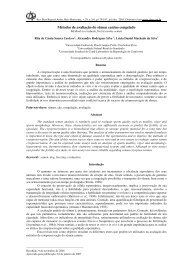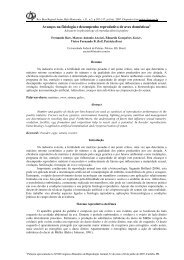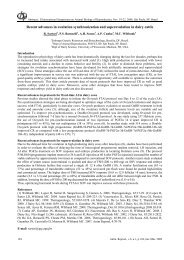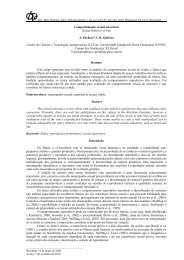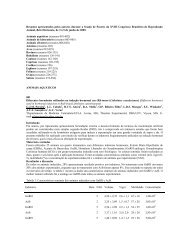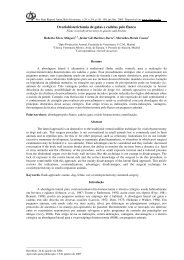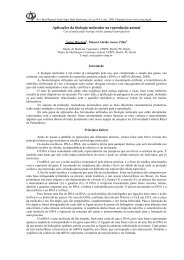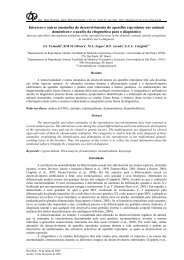Endocrine control of ovarian function in dogs and other carnivores
Endocrine control of ovarian function in dogs and other carnivores
Endocrine control of ovarian function in dogs and other carnivores
You also want an ePaper? Increase the reach of your titles
YUMPU automatically turns print PDFs into web optimized ePapers that Google loves.
Concannon et al. Ovarian <strong>function</strong> <strong>in</strong> <strong>dogs</strong> <strong>and</strong> <strong>other</strong> <strong>carnivores</strong>.<br />
surge 3-4 days later. Presumably <strong>in</strong>creas<strong>in</strong>g<br />
<strong>in</strong>trafollicular progesterone causes decreases <strong>in</strong> the<br />
LH (ng/ml)<br />
20<br />
15<br />
10<br />
5<br />
0<br />
Bitch DH25<br />
FSH<br />
LH<br />
ER:PR ratio <strong>in</strong> follicle cells, as suggested <strong>in</strong> <strong>other</strong><br />
species, <strong>and</strong> participates <strong>in</strong> the ovulatory process.<br />
-30 -25 -20 -15 -10 -5 0<br />
Days from LH surge<br />
Figuire 5a. Changes <strong>in</strong> LH <strong>and</strong> FSH dur<strong>in</strong>g anestrus <strong>and</strong> proestrus <strong>in</strong> a bitch with <strong>in</strong>creases <strong>in</strong> LH 5-8 fold higher<br />
than previous mean concentrations, as well as <strong>in</strong>creases <strong>in</strong> FSH 1-fold higher than <strong>in</strong> anestrus. This is an example <strong>of</strong><br />
transiently <strong>in</strong>creased mean LH levels that are typically 300-3000% greater than those earlier <strong>in</strong> anestrus, occurr<strong>in</strong>g<br />
as a result <strong>of</strong> a late anestrus <strong>in</strong>creased frequency <strong>of</strong> LH pulses <strong>of</strong> near preovulatory peak magnitude.<br />
Estrus, LH surge, ovulation <strong>and</strong> sex behavior<br />
Ovulation <strong>of</strong> immature oocytes occurs 48-60 h<br />
after the LH surge. Both the LH surge <strong>and</strong> overt estrus<br />
sex behavior beg<strong>in</strong> either at or, more <strong>of</strong>ten, immediately<br />
after the peak <strong>in</strong> estradiol (Concannon et al., 1975;<br />
Olson et al., 1982; Concannon, 1993). The precipitat<strong>in</strong>g<br />
event is the rapid spontaneous decl<strong>in</strong>e <strong>in</strong> the E:P ratio as<br />
estradiol atta<strong>in</strong>s peak concentrations <strong>and</strong>/or beg<strong>in</strong>s to<br />
decl<strong>in</strong>e. In some cycles, there may be a secondary rise<br />
<strong>in</strong> estradiol dur<strong>in</strong>g the LH surge to near peak or peak<br />
levels, but at a time when progesterone is rapidly<br />
<strong>in</strong>creas<strong>in</strong>g <strong>and</strong> the E:P ratio decl<strong>in</strong><strong>in</strong>g. The late<br />
proestrus spontaneous rise <strong>in</strong> progesterone <strong>and</strong> the<br />
subsequent <strong>in</strong>itial LH surge-promoted acute rise <strong>in</strong><br />
progesterone both exacerbate the decl<strong>in</strong>e <strong>in</strong> E:P ratio.<br />
Progesterone thereby participates <strong>in</strong> facilitat<strong>in</strong>g both the<br />
onset <strong>and</strong> completion <strong>of</strong> the LH surge. Increased<br />
progesterone is assumed to be among the signals for<br />
<strong>in</strong>itiation <strong>of</strong> oocyte maturation <strong>and</strong> changes <strong>in</strong> the<br />
pathways lead<strong>in</strong>g to the <strong>in</strong>creased <strong>in</strong>tra-follicle PG<br />
production required for ovulation as reported <strong>in</strong> <strong>other</strong><br />
species. The latter <strong>in</strong>clude decreases <strong>in</strong> cytosolic ER <strong>and</strong><br />
PR, <strong>and</strong> b<strong>in</strong>d<strong>in</strong>g <strong>of</strong> progesterone to PMRs (progesterone<br />
membrane receptors). It is possible that a gonadotroph<strong>in</strong><br />
surge regardless <strong>of</strong> whether it is predom<strong>in</strong>antly or nearly<br />
exclusively one <strong>of</strong> LH or <strong>of</strong> FSH <strong>in</strong> activity can elicit<br />
ovulation, consider<strong>in</strong>g that FSH deficient <strong>and</strong> LH<br />
deficient surges have been identified <strong>in</strong> a few normal<br />
cycles <strong>and</strong> <strong>in</strong> some GnRH-agonist <strong>in</strong>duced fertile<br />
cycles. The extent to which ovulation has the potential<br />
to occur spontaneously at the end <strong>of</strong> the follicular phase,<br />
even though almost always facilitated or precipitated by<br />
a <strong>ovarian</strong>-signaled, properly timed gonadotroph<strong>in</strong> surge<br />
is also not known.<br />
The evidence support<strong>in</strong>g a critical role for the<br />
late proestrus decl<strong>in</strong>e <strong>in</strong> the E:P ratio as the ultimate<br />
trigger for LH surge release <strong>and</strong> onset <strong>of</strong> estrus behaviors<br />
<strong>in</strong>volves the temporal relations among these changes (Fig.<br />
8) as well as studies <strong>in</strong> ovariectomized bitches<br />
adm<strong>in</strong>istered estradiol with or without subsequent<br />
progesterone. The onset <strong>of</strong> estrus behaviors typically is<br />
co<strong>in</strong>cident with the LH surge, but may occur 1-4 days later,<br />
<strong>and</strong> <strong>in</strong> some <strong>in</strong>stances never occurs despite normal<br />
hormone pr<strong>of</strong>iles <strong>and</strong> fertile ovulation demonstrated by AI.<br />
The major component <strong>of</strong> the LH surge, the LH peak, <strong>and</strong><br />
Anim. Reprod., v.6, n.1, p.172-193, Jan./Mar. 2009 177<br />
600<br />
500<br />
400<br />
300<br />
200<br />
100<br />
0<br />
FSH (ng/ml)


